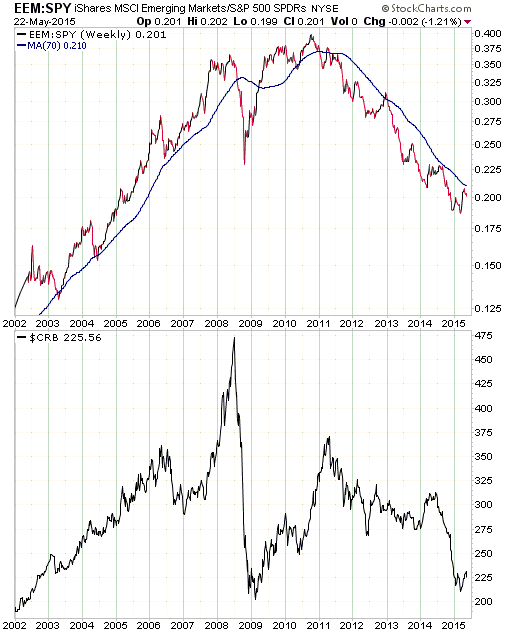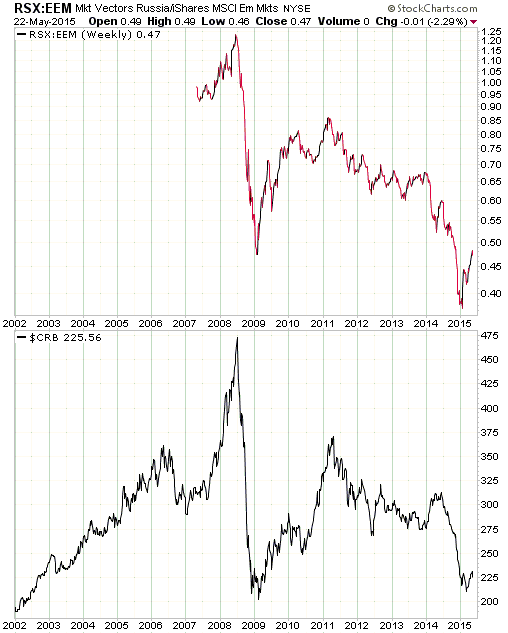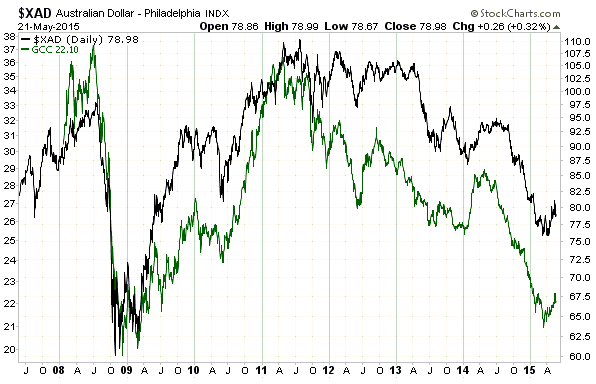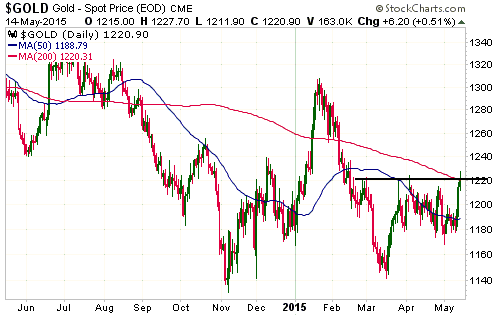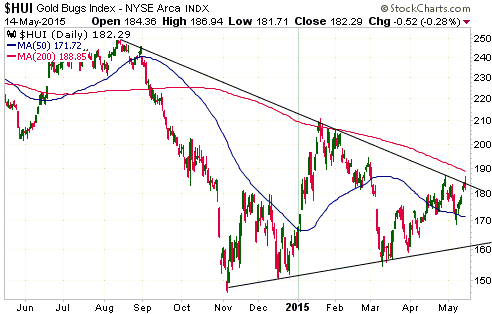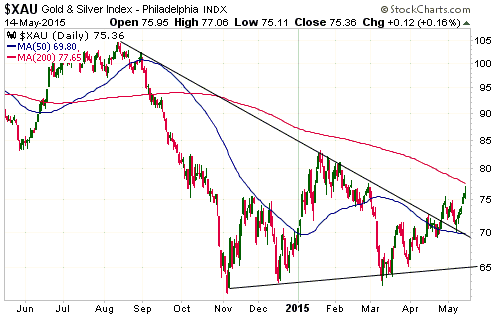The title of this post refers to the debate between Jeff Clark and Harry Dent about gold’s prospects over the next 2 years, with Harry Dent arguing for a collapse in the gold price to less than $700/oz and Jeff Clark arguing in favour of a bullish outcome. I put inverted commas around the word great, because neither participant in this debate made a good argument. However, while the Clark side of the debate could have been a lot better, the Dent side was a stream of complete nonsense. In this post I’ll deal with a couple of the flaws in Dent’s analysis and also briefly address the extremely persistent deflation fantasy that lies at the core of Dent’s latest big prediction*.
An important point to understand is that gold is not now, and has never been, a play on “CPI inflation”. As I stated in an earlier post: “Gold is a play on the economic weakness caused by bad policy and on declining confidence in the banking establishment (led by the Fed in the US). That’s why cyclical gold bull markets are invariably born of banking/financial crisis and/or recession, and why a cyclical gold bull market is more likely to begin amidst rising deflation fear than rising inflation fear.” Jeff Clark barely touches on this key point, while Harry Dent believes that the point is invalidated by the fact that the gold price fell by 33% during part of the 2008 financial crisis.
Harry Dent keeps returning to gold’s performance during 2008 and provides no other historical examples of gold performing poorly in times of financial crisis. He therefore either has very little knowledge of gold’s historical record or he believes that hundreds of years of history were negated by what happened during 2008. Either way, he is misinformed, because gold outperformed the US$ over the course of 2008. The 33% decline is from the best level of the year to the worst level of the year, but even this sizeable peak-to-trough loss was fully eradicated by the first quarter of 2009. Moreover, if we consider the entire Global Financial Crisis (GFC), with the 10th October 2007 closing high for the S&P500 marking its beginning and the 10th March 2009 closing low for the S&P500 marking its end, we find that gold gained 24% in US$ terms and 34% in euro terms over the course of the crisis.
Information that must always be taken into account when assessing gold’s performance in reaction to events is the gold-price starting point. The reason that gold was initially hit hard in US$ terms during the general market crash of 2008-2009 is largely due to the US$ gold price being ‘overbought’ and at a multi-decade high just prior to the crash, which is obviously not the case today. Furthermore, as I mentioned above it quickly recouped its losses.
And information that must be taken into account when assessing the performances of all the financial markets during the GFC of 2007-2009 is that the Fed did not begin to pump-up the US money supply (properly measured via TMS) until September of 2008. From September of 2007 through to August of 2008 the Fed cut interest rates, but the monetary inflation rate remained at a low level. Since there is no longer any scope to cut interest rates, it’s a virtual certainty that the Fed’s initial response to a deflation scare in the not-too-distant future would involve ramping-up the money pumps.
In addition to presenting gold’s GFC performance in a misleading way, there are numerous problems with Dent’s argument. Due to time constraints I’m only going to deal with one of them. Here’s the relevant excerpt:
“The gold bug camp is constantly telling us that governments are debasing our currency, especially the almighty US dollar and destroying the value so that the dollar is not a good store of value. I 100% disagree.
Here’s an analogy to explain: Since its invention in 1971, the microchip has been multiplied by the trillions, creating a revolution in human communications. Its evolution is a crystal-clear sign of progress and of a higher standard of living. Translating that back to the dollar argument, if the exponential multiplication of the microchip was (is) a good thing, why would the multiplication of dollars not also be a sign of progress that similarly fosters a revolution in urbanization, more complex and rich specialization of skills, and an improved standard of living? Increasing urbanization leads to rising affluence and the need for greater dollars for transactions in a more complex urban society!”
This may be the stupidest economics-related comment I’ve ever read from a trained economist, which is saying something considering the competition. It implies that he doesn’t know the difference between a rise in the quantity of the medium of exchange and a rise in the quantity of real wealth. It implies that he sees no difference between the private sector increasing the supply of labour-saving or life-sustaining or life-enhancing products and central banks creating new money out of nothing. Also, he apparently perceives the factual decline in the US dollar’s purchasing power as a goldbug delusion.
Harry Dent should not be taken seriously, but the view that deflation is coming should not be dismissed out of hand. Also, it is possible to make a legitimate gold-bearish argument, it’s just that Harry Dent hasn’t done it.
Under the current monetary system and the theories that dominate central banking, true deflation — such as occurred in the US during 1930-1932 — has a near-zero probability of happening. In the future there could (almost certainly will) be changes to the monetary system and/or the political environment that pave the way for true deflation, but that’s not something that has a realistic chance of happening over the next two years. In the meantime, there will probably be another deflation scare.
While it’s in progress a deflation scare will look and feel like 1930s-style deflation to most people. The difference is that you don’t get the economic ‘reset’ that would be caused by true deflation. Instead, policy-makers react to the scare by 1) aggressively injecting new money into the economy, 2) ensuring that the total volume of credit continues to grow, and 3) generally doing whatever it takes to prop-up prices. In doing so they add new imbalances to the existing imbalances.
Deflation scares are very bullish for gold. That’s why the deflation scare of 2001-2002 set in motion a large multi-year advance in the gold price and why the deflation scare of 2007-2009 set in motion a large multi-year advance in the gold price. If another deflation scare gets underway this year then so, in all likelihood, will another large multi-year advance in the gold price.
Looking out over the coming 1-2 years, the risk for gold isn’t that there will be true deflation, because that’s a virtual impossibility under the current monetary set-up. Nor is the realistic possibility of a deflation scare a risk for gold, since such a development would create a very gold-bullish fundamental backdrop. Rather, the risk for gold is a continuation of the monetary-inflation-fueled boom of the past few years.
In effect, the main risk for gold is an economic outcome that is almost the OPPOSITE of what Harry Dent is predicting.
*Harry Dent’s modus operandi is to come out with a new ‘big prediction’ almost every year. This creates a media buzz that facilitates the sale of books. If a big prediction doesn’t pan out, no problem — just make another one. Eventually, one will hit the mark. In the early-1990s he got lucky and correctly predicted the ensuing boom (it was blind luck because his reasoning was wrong). If he gets lucky again, he’ll have a track record to shout from the hilltops.
 Print This Post
Print This Post

